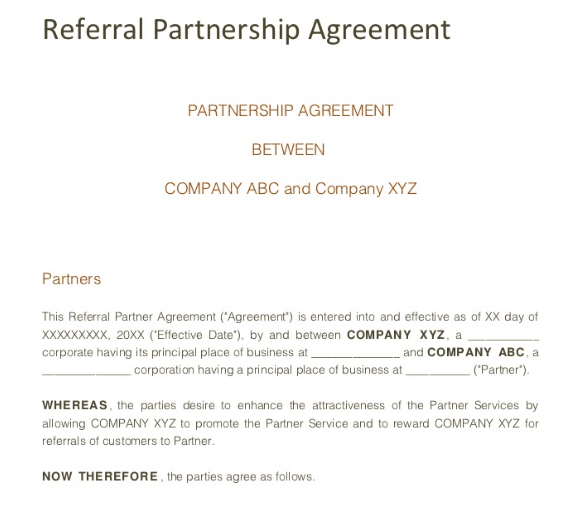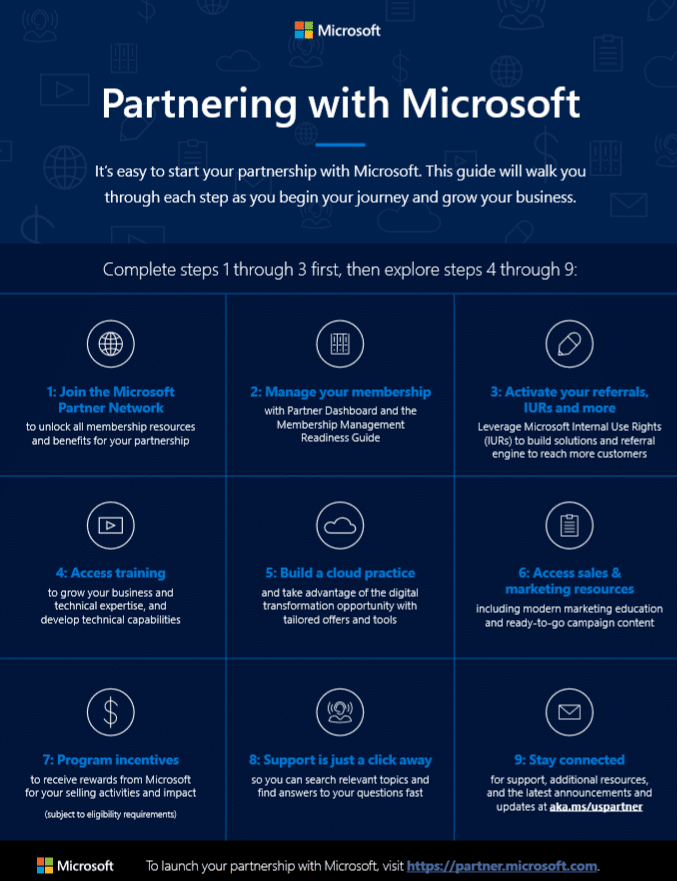You have a good number of loyal customers. And you’re starting to see sales come in from customer referrals. Why not take a step further and explore formal referral partnerships?
Referral partnerships (also called referral partner programs) may be the missing piece in your marketing campaign, especially if you’re a B2B. They’re a proven way to bring in qualified leads through building word of mouth and existing relationships.
In this article, we define what a referral partnership is, how it compares to other types of channel partnerships, and how to create a successful referral partner program to scale your business growth in 14 steps.
What is a referral partner?
A referral partner is an individual, or a business, who willingly recommends your brand to the people they know.
As a close associate of your business, a referral partner will recommend your products or services to people they’ve built relationships with in exchange for rewards.
A partner could be someone at a related but non-competing business who refers their own customers to you, someone who provides a value-added service that complements or an existing B2B customer who refers people at other businesses they’ve built a connection with.
Referral partnerships are a type of channel partnership. (Although the structure of referral partnerships may seem similar to a customer referral program structure, referral partnerships are more formal.)
Like most channel partnerships, referral partnerships typically start with a formalized and detailed agreement with another person or business. That person or business agrees to promote your products or services to potential customers.
Every time the referral partner generates a new sale for your business, they earn a commission – a referral fee – as a reward for the successful referral.
Benefits of referral partnerships: What sets referral partners apart?
Referral partnerships are different from other channel partnerships in two important ways. These differences bring a whole host of unique benefits.
First, referral partners already have experience with, or close knowledge of, your product or service. They’re either existing B2B customers turned strong advocates, or people at non-competing businesses who know their own customers could benefit from becoming your clients. They know the strengths of your brand and are able to authentically communicate these selling points to a referral. This may improve their chances of identifying potential ideal customers to refer.
Also, referral partners only refer people or businesses they’ve already built a personal connection with. For instance, if the partner’s a representative at a non-competing business, they’ll refer their own customers to you.
This pre-existing relationship is powerful when it comes to closing sales. The referred party trusts the referral partner’s recommendation, making them more willing to investigate your product or service and ultimately make a purchase.
Referral partnerships also tend to bring in higher quality leads, who are likely to remain your customers for longer periods of time. This results in improved customer retention and a higher average customer lifetime value.
Even though the lead pool that referral partners draw from is noticeably smaller (since they’re only recommending you to people they know), the quality of leads and the trust factor make up for this.
These two factors – familiarity with your product and existing relationships – lead to a more efficient sales cycle for your company. Referred leads close faster, so you ultimately spend less on marketing and reap an increased ROI. Referral partners do the bulk of your marketing for you!
Referral partnerships vs. other channel partnerships
How do referral partnerships differ from similar types of channel partnerships? Here’s the lowdown for you to compare and figure out the best partnerships for your business.
Of course, you can always engage in multiple types of channel partnerships, so don’t be afraid to combine approaches.
Referral partnerships vs. affiliate partnerships
Affiliate marketing partnerships have a lot in common with referral partnerships because both types of partners help generate sales in exchange for cash commission.
However, affiliate partners are often content creators, such as bloggers or podcasters. Affiliates use their own channels (blogs, websites, or social media profiles) to promote your products or services to their large audiences of followers.
In most cases, affiliates don’t personally know the members of their audience. So even though affiliate partners may speak to a wider audience than referral partners, they don’t usually have the personal relationships with leads that referral partners have.
Affiliate partners are focused on high-level sharing and casting a wide net, whereas referral partners have a closer-knit relationship with the leads they bring.
Because a referral partnership is relationship based, those partners do a lot more work either in the qualifying of the leads, or the actual selling on your business’ behalf. The volume of leads that referral partners bring in might be less than that of affiliates, but the quality is higher.
In addition, affiliates don’t often have an authentic experience with your brand, or close familiarity with it. This can result in leads that are lower in quality or take longer to close, compared to the potential new customers your referral partners bring in.
Which is best for you?
Are referral partners or affiliate partners a better fit for your business? It depends on your company type, longevity, and situation. Here’s a handy comparison.
| Referral partner | Affiliate partner |
| Brings in higher-quality leads, but in much smaller quantities | Delivers a higher quantity of leads, but of varied quality |
| Works better if your business appeals to a very specific niche | Works better when your product has near-universal appeal |
| Less of a financial risk because of the quality of leads they bring in (it’s often less expensive to nurture a referral lead than an affiliate lead) | Allows you to cast a wider net, but requires a larger marketing budget and a bit more risk |
| More work for the partner per sale, but sales tend to be higher in dollar value so the partner gets a solid ROI | Affiliates don’t nurture leads in the same way, they just send as many leads as they can to you |
| More accessible to small businesses and startups | Generally not as accessible to smaller and earlier-stage businesses, due to their potential cost (commission fees, plus potential lead nurturing costs vs. referral partner leads) |
Referral partnerships vs. other channel partnerships
Referral partnerships are very different from most other channel partnerships. Referral partners aren’t like distributors, wholesalers, or resellers because they don’t purchase quantities of your products to sell as a third-party.
Referral partners are more similar to agents or brokers, who help establish partnerships between your business and the businesses they have a relationship with. What sets referral partners apart from agents is that referral partners always build the relationship well before the sale, and some have personally used the product themselves.
How do you create a referral partnership? 14 steps to start a referral partner program
Now that you know the basics about referral partners, you’re probably wondering how to build referral partnerships – and how to maintain a successful referral partner program. Not to worry – we’ve got you covered.
We’ve rounded up the 14 best practices for establishing solid referral partnerships:
- Make sure your product or service is worth referring
- Look for potential referral partners
- Reach out to handpicked potential partners with an offer they’ll value
- Create a referral partner marketing agreement
- Make onboarding a smooth experience
- Ensure referral partners clearly understand the ideal customer
- Walk through your value proposition and selling points
- Train partners in how your product or service stands out from the competition
- Give portal access
- Incentivize partners for all sales
- Recognize partners with shout-outs and thanks
- Reach out to partners who may need more guidance
- Communicate regularly with partners
- Use PRM software to properly track and reward partner referrals
1. Make sure your product or service is worth referring
Before finding new referral partners, make sure your brand is worth recommending in the first place. Is your product or service consistently earning positive reviews? Are customers already recommending your brand to their friends and colleagues?
If so, you’re ready to move forward with a referral partnership program. But if not, focus on refining your offerings and your customer service first. You’ll reap the most benefit from a referral partnership if your business is one customers want to refer.
2. Look for potential referral partners
How do you build referral partnerships that bring you the best results?
It’s best to consider related but non-competing businesses whom you share an audience with. Which businesses have customers who could benefit from your services, or have products that work with yours to bring muutual value? And do any companies already naturally refer customers to you without the prospect of a reward?
Your best existing customers may also make solid referral partners, especially if they have recommended you to others or left a positive review. But make sure they have a strong network of relationships, especially within your brand’s target audience.

It’s fine to promote your partner program publicly and have customers apply. But ultimately, you’ll need to vet and handpick the best referral partners.
3. Reach out to handpicked potential partners with an offer they’ll value
Once you’ve identified your ideal partners, it’s time to reach out to them.
Remember that you’ll first need to provide value to your potential partners before they agree to make referrals. Besides a commission on every successful referral, what’s in it for them?
Identify how you can help contribute to their business or career in return for the referrals. Could you help them accomplish their goals? Provide educational resources? Or even agree to send some referrals their way? Don’t be afraid to ask what would be valuable to them!
4. Create a referral partner marketing agreement
Once a referral partner is ready to sign on to your program, it’s time to set guidelines and create a written partner marketing agreement.
A referral partnership agreement should include:
- What each party (your business and the partner) is responsible for providing and accomplishing
- Commission terms: What is the commission rate? Is it fixed or tiered? What must happen for a partner to earn a commission?
- Information about your ideal audience, value proposition, and ways your product stands out from the competition
- Expectations for how your partner can and cannot promote your product
This written agreement will hold both of you accountable. It’s important to read, understand, and sign this binding agreement before engaging in a formal referral partnership.

In our other article, we cover everything you should include in any type of channel partner agreement.
5. Make onboarding a smooth experience
To help your referral partners be as successful as possible, you need a smooth onboarding process. These first few days or weeks sets the tone for how your partners will best recommend your product or service to others. Here are some topics to cover:
- How should your brand be represented?
- Who are your ideal clients?
- What differentiates you from the competition?

6. Ensure referral partners clearly understand the ideal customer
Train referral partners on key aspects of your ideal buyer persona. It’s important they know when a person or business they’re connected with might be a good fit for your product or service:
- Buyer demographics (age, gender, location, job title and duties, role in the business buying process if the product is for B2Bs)
- Buyer needs and pain points
- The buyer’s values and key behaviors
- Obstacles that may keep them from purchasing
- If you’re a B2B, information about the ideal company profile for your product: size, niche, reasons the company would need your product or service
Make sure your buyer persona information is in writing and readily available to partners.
7. Walk through your value proposition and selling points
What makes your product attractive to potential clients? What value does it offer, particularly ones that set it apart from the competition?
Make your values clear and well-documented in a place partners can access whenever they need it.
Consider creating a PDF or video explainer of your value proposition, enabling your partners to have something they can share to their referrals.
8. Train partners in how your product or service stands out from the competition
How is your product different from – and better than – competing offerings?
Even though your partners have likely done their research before coming to you, this differentiation from competitors might not be as clear in their minds now.
Provide a list of key points that set your product apart from the rest of your market, and how these differences provide clear benefits for referred leads.
You could provide this training via webinars, Zoom calls, or via a partner portal (where partners can progress through at their own pace).
9. Give them access to a portal
The easier (and more trackable!) the referral process is, the more success your referral partner program will have in generating leads and sales.
Because a referral partnership is relationship based, they might not use a link sharing system that often (although it’s still a good practice to give them that option). Even within a partnership platform, they’ll tend to add referrals on their own.
So, it’s vital to give partners access to a portal to add new referrals, track the status of those referrals, see where people are in the sales process. This will give them a very detailed understanding of everything that’s going on with the leads that they referred.
PRM software will help you track sharing and set up a partner portal – more on why this software is so vital below.
10. Incentivize partners for all sales
Every time your referral partners bring in new clients, you should incentivize them with some sort of commission or reward.
Usually, this commission will be in cash, either as a percentage of each sale or a fixed amount. But you can also incentivize partners with product credits, or with a motivating gift-type of reward that will be useful for their business.
(If you’re a B2B with a longer sales process, you might also pay partners a smaller commission for qualified leads, and then a larger commission on sales made.)
No matter which reward you choose, it should be attractive and fair to your partners, but also sustainable enough for your business to pay immediately after each sale.
Another idea is to offer bonuses for referral partners when the lifetime sales they bring exceeds a certain threshold. (This could be a one-time gift or cash reward, or a permanent commission increase.) In addition, consider retention bonuses if a partner’s referral makes a repeat purchase or renews their subscription.
These articles on channel partner incentives and affiliate commissions may also help you set up the best commissions for referral partners.
11. Recognize partners with shout-outs and thanks
Intrinsic incentives are just as vital in creating a strong referral partner program. They let partners know they’re appreciated. A monthly spotlight on social media, or in an email newsletters is one way to do so.
You could also create partner-only educational sessions or events, or even treat partners to personal dinners. And of course, regular and heartfelt thank-yous (especially in print notes) go a very long way.
12. Reach out to partners who may need more guidance
Is one of your referral partners still unsure about who to recommend a product to? Do they appear to need some more coaching about your selling points? These struggles may lead referral partners to have difficulties bringing in sales.
One crucial aspect of referral partner program support is reaching out whenever a partner might need some assistance. This can smooth out any hiccups and increase the chances of referrals leading to a sale.
Some reasons a referral partner may need extra support include:
- They aren’t clear on your target audience, so the peers they refer aren’t the best fit for your company
- They aren’t sure about the right time to make a referral, so they’re hesitant to recommend you
- They don’t know how best to communicate your value proposition, selling points, or ways the product stands out from competitors, so peers aren’t convinced
13. Communicate regularly with partners
Regardless of whether a partner is thriving or needing more support, keep the lines of communication open between you and your partners.
Make sure partners know how to reach you if they have questions, via multiple channels. Also, regularly check in with partners to set times, regardless of how well they’re doing. They’ll appreciate how much you care!
14. Use PRM software to properly track and reward partner referrals
The data and tasks involved in managing a referral partner program can be overwhelming – especially if you work with many partners.
To keep partners happy, you need to reward them as soon as they make a sale. And it’s nearly impossible to manually track the success of every single referral partners.
To start a successful referral partner relationship, consider having PRM software (partner relationship management software) at the ready.
PRM software makes it much easier for your company to train, track, and manage relationships with your referral partners. It streamlines all the tasks associated with your partnership, which makes it a must for any successful partner program.
Some of the tasks PRM software can assist you with include:
- Onboarding and training partners
- Communicating with partners
- Sharing vital training documents with referral partners
- Sharing information for referral partners to share with their network
- Distributing unique referral links
- Tracking and measuring the success of each partnership in real time
- Allowing partners to keep tabs on the status of their referrals
- Rewarding your referral partners in an efficient manner
Wrapping up
Have you decided that referral partnerships are right for you? Handpick customers with strong networks, then set expectations for the partnership with a referral partner agreement. Make sure your partners are well-trained in how to share the benefits of your brand, incentivize them well when they help bring in sales, and communicate with them regularly.
And for the most efficient partnership management, be sure to select the right PRM software.
Check out how our flexible referral marketing software can be customized to suit your business needs, and help to efficiently manage, track, and incentivize referral partnerships.




